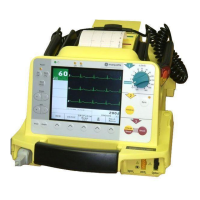Putting the Device Into Operation and Performance Check
227 490 02-C Marquette Responder® 3000 9
3 Putting the Device into Operation and Performance Check
Safety information
Danger
Explosion Hazard – The device is not designed for
use in areas of medically used rooms where an
explosion hazard may occur. An explosion hazard
may result from the use of flammable anesthetics,
skin cleansing agents and disinfectants.
Also, it is not permitted to operate the defibrillator
in an oxygen-enriched environment or in the
presence of flammable substances (gas) or anes-
thetics.
Oxygenation in the vicinity of the defibrillation
electrodes must be strictly avoided. Temporarily
interrupt the oxygen supply.
Warning
Shock Hazard — Observe the following warnings.
Otherwise the lives of the patient, the user and
bystanders are in danger.
-
The Marquette Responder® 3000 is a high-
voltage electrotherapy device and must be
handled by qualified and specially trained per-
sonnel. Improper use of the device can endan-
ger life. Always follow the instructions given
in the operator's manual.
-
When equipped with the AC power adapter, do
not use the defibrillator outdoors because the
power adapter is not splash-proof.
-
Before using the device, the operator must
ascertain that it is in correct working order
and operating condition. In particular, all
connectors, electrodes as well as sensors and
probes must be checked for signs of damage.
Damaged parts must be replaced immediately,
before use.
-
When disconnecting the device from the power
line, remove the plug from the wall outlet first,
before disconnecting the cable from the de-
vice. Otherwise there is a risk of coming in
contact with line voltage by inadvertently in-
troducing metal parts in the socket of the
power cord.
-
As a general rule, utmost caution is advised
for intracardiac application of medical techni-
cal devices. Great care must be exercised to
prevent that conductive parts (connectors,
electrodes, transducers) connected to the iso-
lated patient signal input come in contact with
other grounded conductive parts, as this could
bridge the patient's isolation and cancel the
protection provided by the isolated input.

